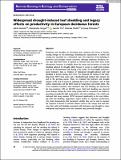Por favor, use este identificador para citar o enlazar a este item:
http://hdl.handle.net/10261/340042COMPARTIR / EXPORTAR:
 SHARE SHARE
 CORE
BASE CORE
BASE
|
|
| Visualizar otros formatos: MARC | Dublin Core | RDF | ORE | MODS | METS | DIDL | DATACITE | |

| Título: | Widespread drought-induced leaf shedding and legacy effects on productivity in European deciduous forests |
Autor: | Descals, Adrià; Verger, Aleixandre CSIC ORCID; Yin, Gaofei; Filella, Iolanda CSIC ORCID; Peñuelas, Josep CSIC ORCID | Palabras clave: | Deciduous forests Drought responses Early Leaf shedding European heatwaves Land surface phenology Sentinel-2 |
Fecha de publicación: | feb-2023 | Editor: | Zoological Society of London John Wiley & Sons |
Citación: | Remote Sensing in Ecology and Conservation 9(1): 76-89 (2023) | Resumen: | Heatwaves and droughts are becoming more common and severe in Europe, causing changes in tree phenology, disrupting the sequestration of carbon and causing tree mortality on a continental scale. The responses of leaf shedding to heatwaves and droughts remain uncertain, although temperate deciduous forests may shed their leaves if exposed to extreme heat and water stress. Little information, however, is available about the extent and recurrence of early leaf shedding induced by drought, likely because it occurs in small forest patches and can be discriminated only during a few weeks. We used highly spatiotemporal Sentinel-2 data as evidence of widespread drought-induced early leaf shedding in Europe during 2017–2021. We estimated the timing of leaf shedding from NDVI time series and a threshold-based method that extracts the end of the growing season. Then, we evaluated the heatwave and drought impacts at the end of season by analysing the z-score of Landsat-7 and -8 land surface temperature and the ERA5-Land air temperature and aridity index. The 10-m resolution Sentinel-2 data identified early leaf shedding not detected by the low-resolution (250 m) MODIS sensor. Early leaf shedding was observed across Europe during the entire study period and its occurrence was linked to preceding anomalously high temperatures and arid conditions. Our results also indicated that mean summer NDVI decreased significantly in the years following early leaf shedding, suggesting a legacy decline in vegetation productivity. Our study demonstrates that decametric satellite data can be used to monitor the responses of forests to extreme climate events at the canopy level and indicates that early leaf shedding associated with heatwaves and droughts is more widespread and frequent across the continent than previously thought. | Versión del editor: | http://dx.doi.org/10.1002/rse2.296 | URI: | http://hdl.handle.net/10261/340042 | DOI: | 10.1002/rse2.296 | E-ISSN: | 2056-3485 |
| Aparece en las colecciones: | (CIDE) Artículos (CREAF) Artículos |
Ficheros en este ítem:
| Fichero | Descripción | Tamaño | Formato | |
|---|---|---|---|---|
| Widespread_drought-induced_Descals_PV_Art2023.pdf | 4,2 MB | Adobe PDF |  Visualizar/Abrir |
CORE Recommender
SCOPUSTM
Citations
4
checked on 20-abr-2024
WEB OF SCIENCETM
Citations
2
checked on 22-feb-2024
Page view(s)
22
checked on 02-may-2024
Download(s)
16
checked on 02-may-2024
Google ScholarTM
Check
Altmetric
Altmetric
Este item está licenciado bajo una Licencia Creative Commons

